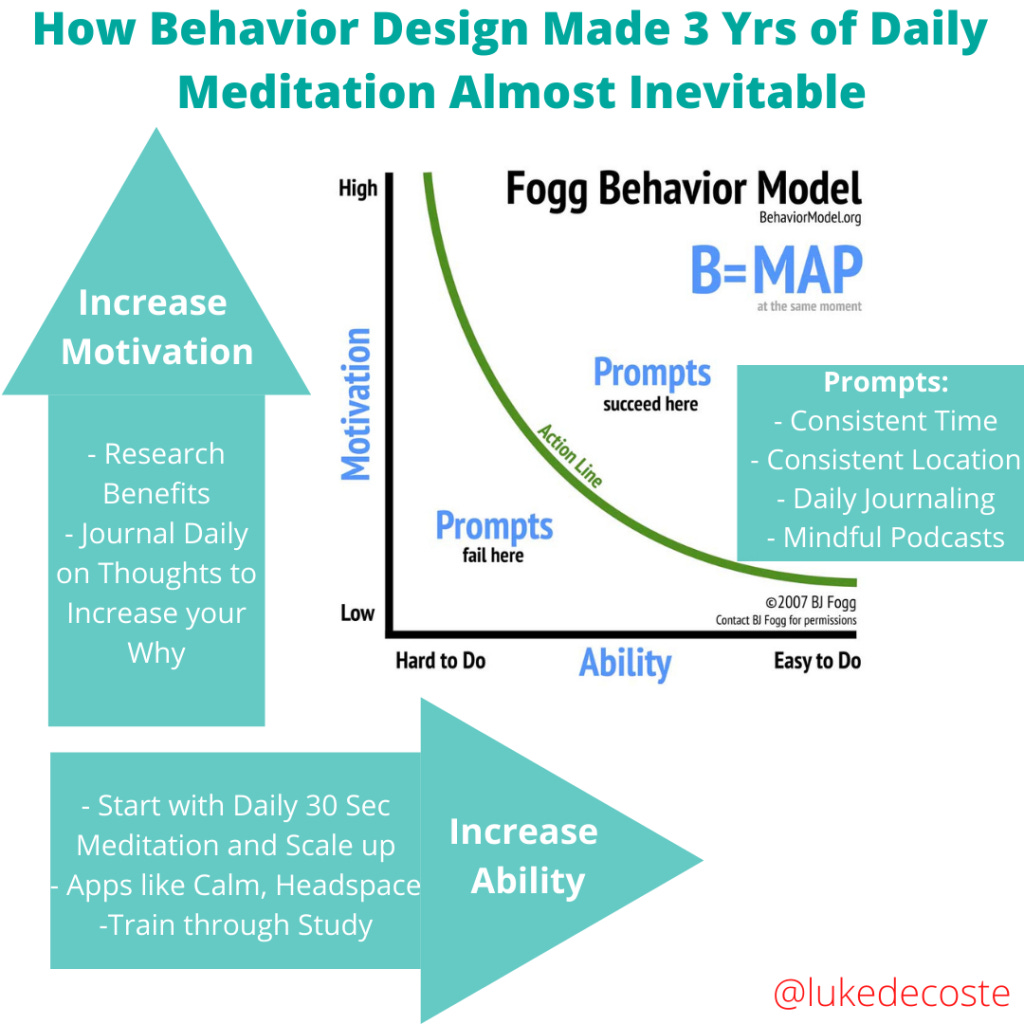How I Actually Meditated for 3 Years Daily.
As it turns out, my three years of meditating daily was inevitable.
At least to someone who designs behavior change like Dr. BJ Fogg.
Fogg Behavior Model
Fogg, known as the founding father of behavior design, spent the last 20 years studying human behavior at Stanford. According to Fogg’s Behavior Model, three things have to happen at once for a behavior to take place: a prompt, an ability, and a motivation.
I’d like to think my three year meditation streak was the result of sheer grit. Fogg’s Behavior Model however shows it was the result of strategically timed prompts, ability-changes, and motivation spikes.
Let me elaborate.
Motivation:

Without realizing it, my motivation to meditate was increasing before I started any routine.
For example, a year before taking on a daily practice, I started a company. Start-ups are stressful. Meditation was a well-known tool for managing stress. My motivation to meditate increased.
Then, three months before starting a daily meditation practice, I was introduced to a simple mindfulness exercise by our company’s executive coach, Urszula. With her encouragement, I began a daily exercise that included taking five breaths, focusing on a different sense with each breath, and then journaling on three questions: 1) How do you feel? 2) What did this practice allow for? 3) What did you discover about your day?
This 30-second exercise made me aware of thoughts like, “there's a lot going on.” This awareness motivated me to meditate. I also began to see the value of mindful pauses. “This practice has been really helpful. I’m feeling calm,” I wrote early on.
Unlike many healthy habits, when I meditate, I want to meditate more. In contrast, flossing my teeth doesn’t make me want to floss my teeth. When I began meditating, I was simply chasing a 30-day run. By 1000 days, I was journaling “this practice has healed me immeasurably.” (I elaborate how here). This positive experience of meditation helped keep my motivation high.
Ability:
Ability is the next requirement of behavior change in Fogg’s Model. The model identifies three ways to increase ability: 1) training, 2) obtaining a tool that makes it easier, and 3) scaling the task back. I benefited from all three.
To train, I was studying books like Search Inside Yourself (by Google’s Jolly Good Fellow - Chade-Meng Tan), podcasts from Reboot.io (a coaching company led by a long time meditator), and from teachers at a local meditation centre.
Two tools increased my ability to meditate: 1) Urszula’s mindfulness exercise described above, and 2) Calm’s meditation app, which offers a free “7 days of calm” program, which I did back to back three times in my first 21 days of meditating.
You can also increase ability by making something easier. The five breath practice explained above was so simple I started meditating without knowing it. From there, scaling up to 10 and then 20 minute meditations was easy.
Prompt:
The final component of the behavior change model are prompts. As Dr. Fogg writes here, “Without a prompt, the target behavior will not happen. Sometimes a prompt can be external, like an alarm sounding. Other times, the prompt can come from our daily routine.”
I was swarmed by prompts. Each time I noted stress in the five breath practice, I was prompted to meditate. When I consumed new information on meditating, I was prompted to practice.
Regular routines also prompted me. Morning meditations help clarify my day, so I began meditating each morning. Soon, simply getting out of bed prompted me to meditate. I was also prompted by the arrival of each Sunday morning, which was when the local meditation center had free drop-ins.
Finally, my environment prompted me. I left a cushion out that I meditated on. When I saw it, I was prompted to reflect on whether I had meditated yet or not.
Conclusion:
If you're starting your meditation journey, and want to talk through it, reach out any time. Even though I’ve done it, I don’t know how. It is impossible to think I could add a 10 or 20 minute activity to my day and do it daily for three years and counting. Clearly I should be more mindful.
